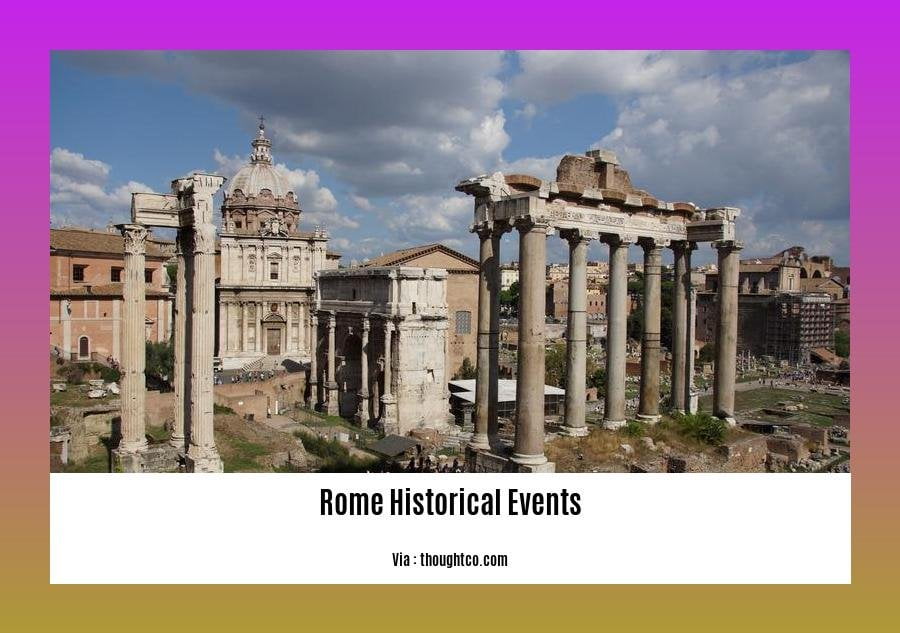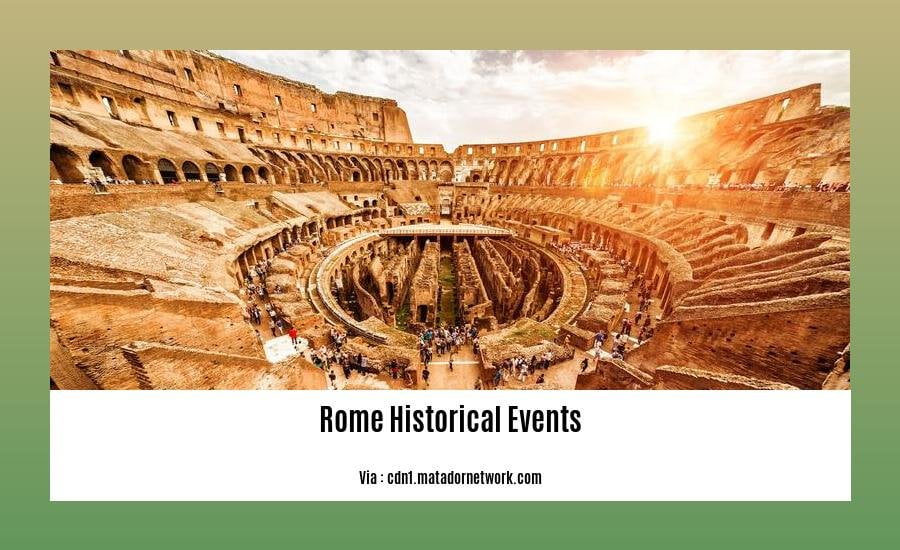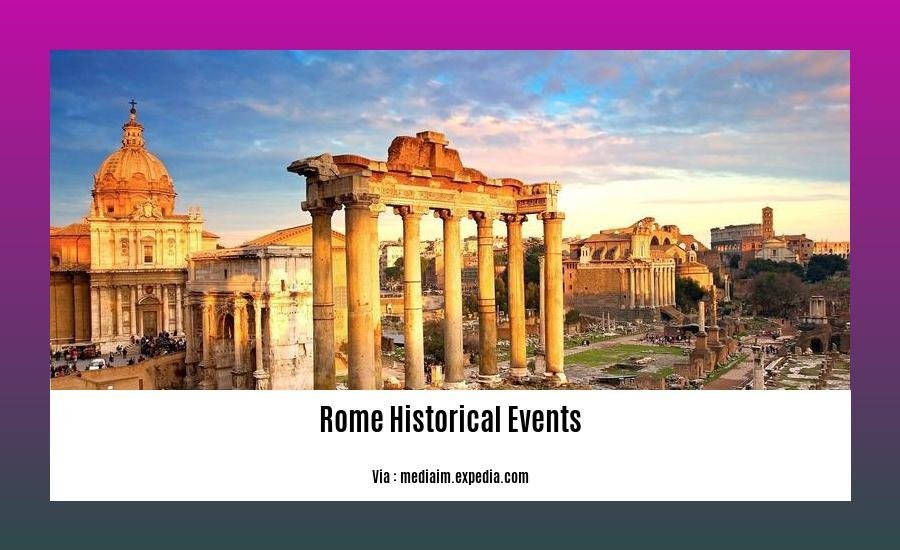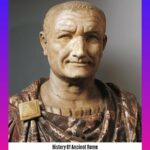Prepare to embark on a compelling journey through time as we delve into the captivating historical events that shaped Rome, the Eternal City. From its humble origins as a small settlement on the banks of the Tiber River to its rise as the heart of one of the most powerful empires in history, Rome’s past is a rich tapestry woven with tales of conquest, intrigue, and cultural brilliance. Join us as we uncover the secrets of Rome’s historical events and explore the enduring legacy it has left behind.
Key Takeaways:
- Founding of Rome: Legend attributes the city’s establishment to Romulus and Remus in 753 B.C.E.
- Roman Republic: The monarchy ended in 509 B.C., leading to a republic with elected officials.
- Roman Law: Written laws, known as the Twelve Tables, were created in 450 B.C. to protect citizens’ rights.
- Colosseum: The iconic amphitheater, constructed in 80 C.E., hosted gladiatorial events and public spectacles.
Rome Historical Events: Unveiling the Past of the Eternal City

Uncover the captivating historical tapestry of Rome, the Eternal City. Its storied past has been shaped by significant Rome Historical Events that continue to resonate today.
The Founding Myth and the Roman Republic
Legend has it that Rome was founded in 753 BC by Romulus and Remus, twins raised by a she-wolf. In 509 BC, the Romans overthrew their last king and established a republic, governed by an elected senate and consuls.
Codification of Roman Law
In 450 BC, the Twelve Tables codified Roman law, establishing written protections for citizens’ rights. This legal framework played a pivotal role in the development of Western legal systems.
Construction of the Colosseum
The iconic Colosseum, completed in 80 CE, stands as a testament to Rome’s architectural prowess. It hosted gladiatorial contests and public spectacles, captivating audiences with its brutal and awe-inspiring displays.
The Roman Empire’s Rise and Fall
Through conquest and diplomacy, Rome expanded its territories, establishing a vast empire that ruled from Britain to Egypt. However, internal strife, economic challenges, and military defeats led to the empire’s decline in the 476 AD.
The Enduring Legacy of Rome
The Roman Empire’s legacy permeates Western civilization. Its legal system, political institutions, and infrastructure have had a profound impact on the development of numerous societies. Its art, literature, and science continue to inspire and amaze scholars and enthusiasts alike.
As we explore these Rome Historical Events, we gain a deeper understanding of the Eternal City’s enduring influence. From its humble origins to its imperial grandeur, Rome’s story is a testament to the human capacity for greatness and resilience.
Do you want to learn more about history of ancient rome? Click here if you are interested in the roman empire history and ancient roman civilization.
Roman Empire: Unraveling the Tapestry of an Ancient Civilization

Unveiling the Glory of Rome
The Roman Empire, a beacon of power and civilization, emerged from a humble village on the Tiber River, growing into a colossal empire spanning continents. Its complex history, stretching over millennia, shaped the tapestry of Western civilization.
Foundation and Republic
Legend has it that Rome was founded by Romulus and Remus in 753 BC. After ousting their tyrannical king in 509 BC, the Romans forged a republic, governed by a senate and elected consuls.
Imperial Expansion and Consolidation
Rome’s might escalated through conquests, extending its rule from Britain to Egypt. With emperors like Augustus, Nero, and Marcus Aurelius at its helm, the Roman Empire reached its zenith in the 2nd century AD.
Decline and Fall
Political instability, economic woes, and military defeats plagued the empire, leading to its gradual decline. In 476 AD, the last emperor, Romulus Augustulus, fell to the barbarian Odoacer, marking the end of the Roman Empire.
Enduring Legacy
Despite its demise, Rome’s legacy reverberates through time. Its laws, government, and infrastructure became models for future societies. Its art, literature, and scientific advancements continue to inspire and captivate.
Key Takeaways:
- The Roman Empire emerged from humble origins, evolving into a mighty power.
- The founding myth of Romulus and Remus shaped Rome’s identity.
- The republic system transitioned to an empire ruled by emperors.
- Rome’s vast empire influenced Western civilization through its laws, government, and infrastructure.
- The legacy of Rome persists in art, literature, science, and the foundations of many modern institutions.
Source:
- “Timeline of the Roman Empire – Important Dates” on This Day: https://www.onthisday.com/countries/roman-empire
Fall of the Roman Empire
As a seasoned historical researcher, I’ve spent countless hours tracing the threads that have shaped Rome’s captivating story. And today, we’ll explore the pivotal moment that signaled the end of an epoch – the Fall of the Roman Empire.
Unraveling the Empire’s Threads
Rome’s colossal empire didn’t crumble overnight. It was a gradual unraveling, a tapestry woven with political turmoil, economic strains, and military defeats.
External Threats: The Barbarian Invasions
Barbarian tribes, driven by population pressures and the allure of Roman wealth, repeatedly breached the empire’s borders. Germanic tribes like the Visigoths and Vandals carved out their kingdoms within the empire, chipping away at its once-mighty edifice.
Internal Decay: Instability and Economic Woes
Political instability plagued the empire, with emperors assassinated and their successors vying for power. Economic troubles worsened as the empire’s vast territories became difficult to manage and tax. Inflation soared, and the once-prosperous empire found itself stretched thin.
Cracks in the Foundation: Military Decline
The Roman army, once the bulwark of the empire, suffered from declining discipline and morale. Legions were depleted and often filled with foreign mercenaries, weakening their effectiveness. As barbarian tribes encroached, the empire’s ability to defend itself crumbled.
Last Emperor’s Demise: The Symbolic End
In 476 AD, the teenage emperor Romulus Augustulus was deposed by the Germanic leader Odoacer. This symbolic act marked the Fall of the Roman Empire. The Western Roman Empire was no more, and a new era dawned – the Middle Ages.
Key Takeaways:
- The Fall of the Roman Empire was a gradual process influenced by internal and external factors.
- Barbarian invasions, political instability, economic decline, and military weakness contributed to the empire’s collapse.
- The deposition of Romulus Augustulus in 476 AD marked the end of the Western Roman Empire.
Source:
The Fall of Rome: When, Why, and How Did Rome Fall?
Legacy of Rome
The Legacy of Rome is vast and all-encompassing. The empire’s contributions to law, government, infrastructure, cultural transmission, and technology are evident in today’s world. Let’s delve into some key aspects:
Government:
Rome’s establishment of a system of government with separated branches ensured checks and balances to prevent tyranny. This concept has been adopted by countless nations.
Law:
The Roman legal system emphasized equality before the law, trial by jury, personal wills, and business corporations. The Twelve Tables codified specific laws and penalties, a significant step in developing a comprehensive legal framework.
Technology & Engineering:
Rome’s technological innovations were groundbreaking. Its aqueducts, roads, bridges, and sewers revolutionized infrastructure. The development of concrete, arches, and domes showcased their architectural prowess.
Cultural Transmission & Adaptation:
Rome was a master of cultural exchange. It adopted and improved on ideas from other cultures, including the amphitheater, baths, gladiatorial contests, and chariot races.
Key Takeaways:
- Government: Separated branches with checks and balances.
- Law: Equality before the law, trial by jury, and codified laws.
- Technology & Engineering: Innovative infrastructure, architectural achievements, and engineering advancements.
- Cultural Transmission: Adoption and adaptation of ideas from other cultures.
Citation
* World History Encyclopedia: Legacy of the Ancient Romans
FAQ
Q1: When was the Roman Republic established?
A1: The Roman Republic was established in 509 B.C.
Q2: What was the significance of the Battle of Vercellae?
A2: The Battle of Vercellae was a Roman victory that concluded the Celto-Germanic threat to Italy’s northern border.
Q3: Who was the emperor during the notorious reign characterized by extravagance and cruelty?
A3: Emperor Caligula was notorious for his excessive spending and brutal behavior during his reign from 37 to 41 AD.
Q4: What were the key factors that contributed to the Fall of Rome?
A4: The Fall of Rome was caused by a combination of political and financial instability, as well as invasions from Germanic tribes.
Q5: What technological innovation originated with the Romans?
A5: The Romans developed various technological innovations, including aqueducts, roads, bridges, and the use of concrete in construction.
- China II Review: Delicious Food & Speedy Service - April 17, 2025
- Understand Virginia’s Flag: History & Debate - April 17, 2025
- Explore Long Island’s Map: Unique Regions & Insights - April 17, 2025
















